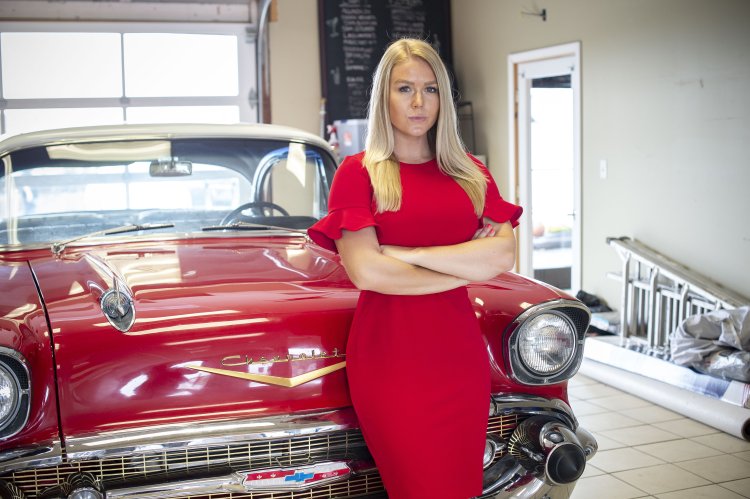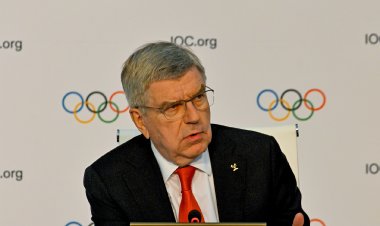The Political Journey of Karoline Leavitt
Prior to her role as Trump's press secretary, she was a 23-year-old devoted supporter of MAGA who was mounting a challenging congressional campaign.

She was in Palm Beach for a fundraising trip related to her challenging congressional campaign. With only five months remaining before the September primary, she was lagging significantly behind her competitors. Leavitt made a strategic move by requesting a meeting with Donald Trump, the figure who had inspired her political ambitions. While she did not anticipate receiving his endorsement, her primary objective was to ensure that he would not support her Republican rival in New Hampshire’s 1st Congressional District race. Upon entering the library, Leavitt found Trump already seated at a table, surrounded by printed polls. True to form, Trump dominated the conversation.
“These don’t look good,” Trump told her.
“Sir, I know they don’t,” Leavitt replied. “But I’m working very hard every day, and I’m telling you, the energy on the ground is different and it hasn’t translated to the polls.” She informed him that she was willing to do whatever it took to turn her campaign around. “I’m just asking,” Leavitt said, “that you let me prove myself and watch.”
At just 23, Leavitt had recently graduated from St. Anselm College. However, she had quickly maneuvered from an internship in the Eisenhower Executive Office Building mailroom to an assistant press secretary role in the first Trump administration, where she stated she fought “against the biased mainstream media,” according to her campaign website. After the 2020 election, she briefly served as communications director for Rep. Elise Stefanik of New York.
Leavitt announced her congressional campaign in July 2021 from her father's used truck dealership in Plaistow, New Hampshire. She was among the first candidates from Gen Z to run for Congress, though she faced competition from a crowded field of nine others and struggled in early polling, registering at just 7 percent when she met with Trump. What set Leavitt apart was her vigorous MAGA platform. She ardently promoted the false narrative that the 2020 presidential election had been stolen from Trump, coinciding with a period when he was increasingly sidelined by mainstream media.
“We’ll keep watching,” Trump said during their meeting, “and maybe we’ll be in touch.”
Her bet paid off. Against the odds, she won the primary and though ultimately losing the general election, the campaign marked her ascent within Trump's circle.
Insights from her competitors and advisers provide a glimpse into Leavitt’s approach, characterized by remarkable confidence at such a young age, especially highlighted in her initial meeting with Trump, as described by multiple individuals familiar with the encounter. She spoke MAGA fluently, which helped her resonate with the target audience.
“Tough as boot leather,” Steve Bannon, an early supporter, remarked, noting how he frequently featured her on his War Room show during the primary. Leavitt learned to engage with Bannon and his audience from Stefanik, whose political maneuvers around Rep. Liz Cheney's leadership challenge in May 2021 provided her with key insights.
These attributes have served her well as she maintains unwavering dedication to Trump’s messaging during her early tenure. Unlike Trump’s previous press secretaries, Leavitt is the only one who has experienced the rigors of a campaign as a candidate, deeply intertwined with Trump’s political identity.
While other press secretaries sometimes appeared uneasy defending Trump’s arguments — with Sean Spicer’s stern demeanor, Sarah Huckabee Sanders’ Southern formality, Stephanie Grisham’s detachment, and Kayleigh McEnany’s polished rhetoric — Leavitt appears to embody Trump's mindset. She enthusiastically counters probing questions from mainstream media and embraces inquiries from right-leaning influencers, amplifying Trump’s anti-media stance while occasionally bending the truth, thus redefining traditional White House-press relations. Journalists in the briefing room have developed concerns regarding potential damages to journalistic norms because of her approach.
Peter Baker, the New York Times' chief White House correspondent, who has worked through various administrations, describes the current atmosphere as unprecedented. He notes, “The current tension goes beyond anything that is traditional to the point of open hostility, and mockery and disparagement in a way that’s meant for the larger audience, not for the people in the room.”
“They don’t view the briefing room as a way to impart information,” Baker elaborated. “They view the briefing room as a theater for the MAGA audience.”
Yet, Leavitt remains undeterred by these dynamics, seemingly enjoying her exchanges with the media. She is as much a product of the Trump era as she is a significant contributor to it.
During her 15-month campaign, critics often pointed out her youth and lack of experience, overlooking how those very attributes could also be advantageous. Growing up in a working-class household, politics came to life for her amid Trump’s rise, without any allegiance to the pre-Trump Republican establishment.
As a conservative student at St. Anselm College, Leavitt witnessed the political landscape shift during the 2016 Republican primary. She even made a brief appearance on television, asking Trump a question during a town hall event.
On August 31, 2016, she penned her first article for her college newspaper, critiquing what she perceived as bias in the media. “Say what you want about Donald Trump,” she wrote, “he is certainly not perfect, but he is without question running against not only a crooked candidate but the crooked and biased media as well.”
In subsequent writings, she addressed various issues, defending Trump's travel ban and discussing how liberal professors influenced classroom discussions. Eager to reach her peers more effectively, Leavitt launched her own television show, frustrated with the delays of the school newspaper’s publication cycle.
Outside campus, she made strides toward her goal of becoming a broadcast journalist, holding a position at Manchester ABC affiliate WMUR where she produced scripts and tracked local police activities.
Graduating in May 2019, she transitioned to a role at the White House correspondence office, later being hired by McEnany as an assistant press secretary after a friend helped her secure the position.
After the election, she briefly served as communications director for Stefanik, aiding her in a political confrontation against Cheney.
In a WMUR interview, Leavitt acknowledged being in the Capitol during the January 6 events while working for Stefanik but has since avoided providing extensive commentary on her experiences that day, an omission considering her emphasis on election integrity.
Initially, she expressed support for Vice President Mike Pence's actions and praised a U.S. Capitol Police officer’s heroism during the tumultuous events. “Karoline said she caught the fire in the belly,” Stefanik recounted as Leavitt considered running for the 1st Congressional District seat against Democratic incumbent Chris Pappas.
Leavitt set up shop at her father’s used car business, incorporating early meetings with her campaign consultant while pitching in on various aspects of the family business. Growing up in a devout Catholic family and attending a Catholic high school made her the first in her immediate family to attend college.
In a district that had not voted Republican since 2014, she knew that she needed the drive to compete against well-established candidates. Before officially launching her campaign, she made a pivotal choice to change consultants from a local GOP strategist to Axiom, a larger firm that recognized her potential and approached her.
During an initial meeting, consultant Ethan Zorfas outlined the daunting challenges ahead. Competing against Matt Mowers, a former Chris Christie aide, posed significant hurdles. Leavitt would need to raise substantial funds to be competitive.
Zorfas expressed uncertainty leaving that meeting: “This is either going to be the best decision I ever made or I just committed political suicide in my home state.”
Zorfas traveled to Plaistow to shape Leavitt’s campaign strategy. Mechanics worked in the background as they discussed crucial messages. With limited resources, Zorfas learned that Leavitt wanted to position herself as a next-generation Republican appealing to younger voters.
She launched her campaign on July 20, 2021, during a Fox & Friends segment billed as a “network exclusive.” Despite unfurling her policy platforms with enthusiasm, she soon articulated how she would represent and amplify the voices of her peers, calling out perceived indoctrination in higher education.
Leavitt insisted that her youth was not the issue but a unique advantage. “If we want real change in our system, we should elect young leaders to reinvigorate our base,” she asserted.
She also broke new ground as a GOP candidate by frequently appearing on Steve Bannon’s War Room show. Bannon recognized her potential in a competitive field, mentioning that others had overlooked her.
“Karoline, out of the gate, had the best understanding of what she needed to do, how to position herself, and how to win,” Tim Baxter, one of her opponents, observed.
Leavitt’s adeptness at addressing cultural issues helped her stand out. On policies regarding transgender athletes, she stated, “We should not be allowing bureaucrats and politicians to stand in the way of the family unit.”
Even as she navigated the complications from the January 6 incident, she maintained a hardline stance against violent rioters, maintaining their actions were not representative of her movement's values.
Her alignment with MAGA rhetoric created a strong fundraising foundation. Within the first two days of her campaign, she raised $100,000, which was impressive for someone with her political background.
However, her focus on election fraud narratives alienated some party leaders. Key figures like then-House Minority Leader Kevin McCarthy and Minority Whip Steve Scalise backed Mowers, leading to a proxy battle in the primary.
Despite Mowers seeking Trump’s endorsement, Leavitt's direct appeal to the former president allowed her to gain an essential edge. Throughout her campaign, she adeptly utilized social media to connect with voters directly while also building rapport with traditional media.
In July, an internal poll showed her gaining momentum, which also drew attention from opponents. Mailers portraying her unfavorably began circulating. Mowers targeted Leavitt with accusations about her character and financial habits in a critical campaign environment.
Though she connected with voters effectively, there were risks involved. Huff Brown positioned herself to leverage issues like abortion in the wake of the Supreme Court's decision on Roe v. Wade, complicating the primary race for Mowers.
By late August, polls indicated a competitive landscape, with Leavitt closing the gap significantly with Mowers.
During the final Mormon broadcast debate, she directly confronted Mowers regarding her background, defending her work experiences passionately. Leavitt won the primary, resulting in a sweeping victory.
After her primary success, she briefly celebrated on social media, receiving Trump’s acknowledgment and congratulations.
However, the general election proved challenging. Pappas won with an 8-point margin, defying expectations of a Republican revival.
Despite the electoral outcome, she raised substantial funds. However, concerns arose about reports of excessive contributions and accounting missteps in her campaign finances.
Reflecting on her experience at a post-election meeting, Leavitt expressed eagerness for future challenges, stating, “This was the best experience I could ever have had... I can't wait for what's next.”
In her position as press secretary, there are no reminders of her congressional campaign; they remain boxed in New Hampshire. Yet her present workplace includes a whiteboard marked with affirmations and lists of Trumpian ideology, symbols of her journey from the White House mailroom to the upper tier of press operations.
Even with her transition from candidate to spokesperson, her views on politically charged subjects have evolved, resonating with a present-day MAGA audience under Trump’s influence. The alignment between her prior campaign and current duties suggests the intertwining paths formalized through her political journey.
As Bannon predicts, “After she’s spokesman for a year or two, I think she’s going to get a Cabinet position.” Leavitt’s understanding of Trump and the MAGA base is rooted in her campaign experience, enabling her to channel them effectively while fostering provocative narratives for the broader audience. Trump's acknowledgment of her electoral loss underscores their shared bond and the trajectory Leavitt continues to follow.As Leavitt settles into her role as press secretary, she faces not only the responsibilities of her position but also the weight of expectations that come with it. Charged with articulating Trump's agenda and managing the administration's relationship with the media, she finds herself embodying the very ideals and conflicts that defined her campaign.
Her press briefings have become a spectacle, drawing attention not only for the content of her messages but also for her combative style. She has perfected the art of deflection and critique, often framing questions from journalists as part of a broader narrative of bias and misinformation. "The mainstream media is not our friend," she has remarked, reinforcing her alignment with Trump’s longstanding narrative about the press.
These briefings are not merely about conveying information; they serve as a platform for rallying the MAGA base, transforming the press room into a theater where grievances against perceived injustices in the media are shared. Journalists have noted that her approach blurs the lines between advocacy and information dissemination.
“Leavitt has harnessed modern communications tactics,” commented Fergus Cullen, the former chair of the New Hampshire GOP. “She has nationalized her primary to get $1,000 checks from middle-aged white guys across the country who are hardcore Trump people.” This sentiment echoes through her communications strategy, often seen as carefully crafted to strengthen her ties with key demographics loyal to Trump.
Moreover, viewers observing her from afar might see in Leavitt an embodiment of the evolving Republican power structure—a young, unapologetic advocate for Trump's ideals who leverages social media and non-traditional media outlets to extend the GOP's reach. Her agile navigation through the terrain of partisan politics has carved out a unique position for her in a party increasingly defined by its loyalty to Trump.
“Seeing her rise has been a manifestation of Trumpism’s influence on the next generation of Republicans,” remarked a longtime Republican strategist. "Leavitt represents a pivot point for the party, merging grassroots enthusiasm with a willingness to engage confrontationally.” In many ways, her trajectory underscores the transition the GOP is undergoing, moving further away from traditional conservatism into a more populist, combative stance.
Despite her strengths, Leavitt's challenges are manifold. The enduring division within the GOP, coupled with the pressure to deliver on expectations set by Trump and his base, places her in a delicate position. Every misstep is scrutinized and amplified by both her allies and adversaries alike, creating an environment of high stakes.
As the administration moves forward, Leavitt faces subjects like the economy, immigration, and foreign policy—issues that Trump’s critics have raised concerns about. Her responsibility is not only to promote the administration's policies but to maintain the fervor of a base that thrives on the perception of government effectiveness through Trump-oriented narratives.
Navigating these complex issues, Leavitt blends her own experiences as a candidate with the tactical acumen she has developed working in the White House. Her backstory of running a campaign defiantly against the odds informs how she approaches challenges now—exhibiting resilience and an understanding of the electorate. The energy that fueled her congressional run continues to manifest in her current role, as she engages both friendly and adversarial press with perseverance.
In briefings, she often channels Trump’s preferred talking points, embedding them in her messaging with near-surgical precision. “Every successful campaign has a story, and Leavitt’s is one of tenacity and the spirit of the MAGA movement,” said an analyst. “It connects with people who feel similarly disenfranchised and resonates deeply with the base that continues to support Trump.”
As her tenure unfolds, it will be interesting to observe how Leavitt will further carve her own identity within the administration while also potentially becoming a key player in the changing landscape of the GOP. The coming months could reveal whether her adeptness at engaging with the public will translate into broader political aspirations down the road.
While winning allegiance among Trump supporters is crucial for her role, the challenge will be maintaining that support amid the shifting political winds as the GOP approaches the next election cycle. Leavitt's ability to navigate between the influences of Trump and the expectations of the broader Republican electorate will define not only her success but also impact the future trajectory of the party.
Whatever her next moves may be, whether it's seeking a more prominent role in governance or continuing to amplify Trump’s message, Karoline Leavitt has positioned herself at the nexus of a new political reality, one that embraces populism and active engagement in the culture wars defined by the current political climate. The journey from a congressional candidate to one of the leading voices in the Trump administration showcases her adaptability and the significant influence of Trumpism on the next generation of Republican leaders.
Anna Muller for TROIB News












